Seoul is usually the starting point for most visitors to South Korea, but many people never venture beyond the city. There are good reasons to travel beyond Seoul to see the provinces and other parts of the country. Fortunately, there are many places you can visit on a day trip from Seoul without staying overnight. And there’s always the option to visit multiple destinations and not necessarily travel back to Seoul each day.
South Korea has been invaded frequently by its larger and more powerful neighbours, divided into North and South Korea. The country has few natural resources other than the tenacity and resourcefulness of its people. South Korea’s highly educated population has emerged from an almost fourth-world status to a first-world powerhouse in little more than half a century.
South Korea has an excellent transportation network and infrastructure that rivals most countries in Europe and North America, achieved despite many obstacles. Now a thriving democracy, when you arrive from abroad, you will be surprised at how modern the country is and that most people in the large metropolitan areas live in high-rise apartment complexes. However, it is not until you travel through the countryside that you will find a surprisingly beautiful landscape amid the medium and large cities.
Spend several days exploring Seoul, its university campuses, shopping areas, palaces and business areas. Coping with Seoul and dealing with traffic and millions of people can be challenging. I recommend visiting the city’s many palaces and markets, such as Namdaemun Market, Dongdaemun Market and Yongsan Electronics Market. Then, travel outside of the capital.
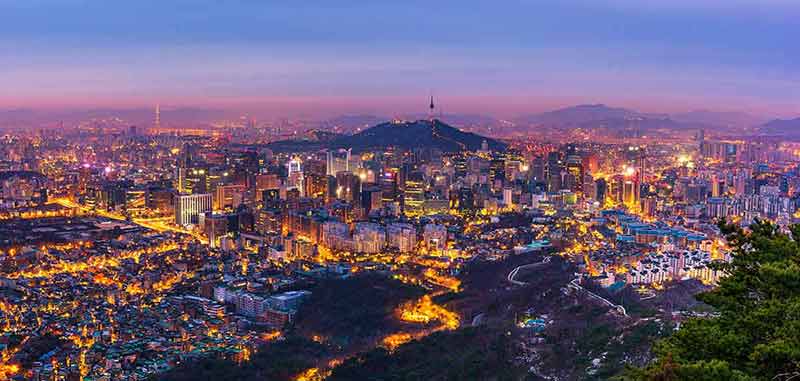
Most visitors take advantage of rail and subway transportation and an excellent bus network. However, there are parts of the country where the surest mode of transportation is by car, particularly if the destination is the smaller towns, provincial and national parks. Highways are extremely crowded on the weekends and hellishly crowded on national holidays, such as Chuseok and the Asian New Year. If you travel by car, use GPS, as the app will alert you to all the highway cameras to help you avoid speeding tickets. Those cameras are easy to spot on the highways and major roads, and the authorities provide drivers with ample warning.
20 Day Trips From Seoul
Day Trips From Seoul – Under 1 hour
1- Lotte World
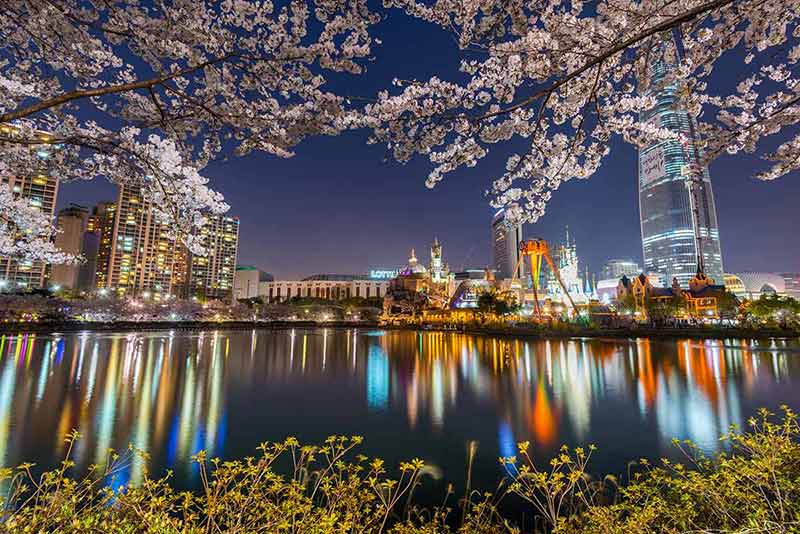
Lotte World is in Seoul’s Songpa District, an amusement park within a building complex divided into Lotte World and Magic Island.
While you are there, don’t miss Lotte World Tower.
If you’re planning an amusement park vacation, South Korea is the place to go, as theme parks are dotted across the country.
Other options are Gyeongju World Park, E-World Daegu, Aiins World in Bucheon City, Maze Land, Shinhwa Theme Park, Eco Land Theme Park on Jesu-do, Wolmi Theme Park on Womido Island, Imsil Cheese Theme Park in Imsil County and Gimhae Lotte Water Park in Gimhae City.
There are several amusement parks in the Greater Seoul Metropolitan Area, and you can easily spend the better part of a day in each park.
It’s worth going on a day trip from Seoul to Everland, South Korea’s equivalent of Disneyland or Seoul Land.
Everland offers parades, rides and several zones such as American Adventure, European Adventure, Magic Land, Global Fair and Zoo-Topia.
Seoul Land is in Gwacheon City within Seoul Grand Park and is one of the best amusement park options for families with young children for its rides, a botanical garden and zoo.
Seoul Land is 19.7 km from Seoul. The travel options are subway (42 minutes) $1 to $2, taxi (20 minutes) $24, drive ($20 minutes) $3 to $4.
Everland is near Yeongin City, 47.2 km from Seoul. The travel options are bus (41 minutes) $10, subway (2 hours), train and bus (2 hours) $3 to $9, taxi (37 minutes) $40 to $55 or drive (37 minutes) $6 to $9. Skip the line and book your ticket here.
Lotte World is 16.3 km from Seoul. The travel options are subway (49 minutes) $1 – $2, taxi (15 minutes) $16 to $20, drive (15 minutes) $2 to $3.
2- Tour of the Demilitarized Zone
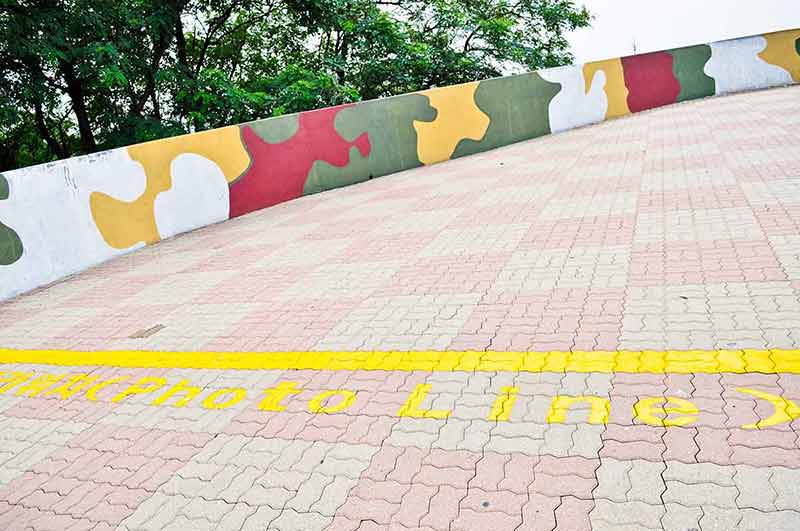
One thing that strikes many travellers is just how close Seoul is to North Korea.
Both North and South are armed to the teeth, and every Korean male must spend 20 months in the South Korean military.
Thousands of U.S. troops are stationed in the country in case North Korea decides to launch an attack.
In the event of war, there are thousands of missiles aimed at Seoul, and those weapons would kill thousands of residents in the south.
Then, the combined armed forces would turn North Korea into a huge smouldering parking lot.
You can visit the DMZ by bus or train, and if you travel to the border, you will see barbed wire and other oddities you will not see elsewhere.
The Demilitarized Zone is a buffer zone that separates the two Koreas, resulting from the Armistice Agreement signed in 1953.
The zone runs from Gyeongi-do to Gangwon-do, and it is an unexpected haven for wildlife.
There are several ways to get to the Demilitarized Zone, but note that many places are outside the civilian control line, so individual travellers cannot be there.
Sign up for various travel packs, including the DMZ Peace Train, and will need passports. Taking photographs is highly restricted.
KORAIL’s DMZ Peace Tour departs from Seoul and is a one-day tour combining the Dorasan Security Tour, the Cheorwon Security Tour, and the Yeoncheon Dreaming Tour.
The Dorasan Security tour brings visitors to Paju at the Dorasan Station, Dorasan Peace Park, the Dora Observatory, and the Third Tunnel.
The North Koreans are constantly digging under the DMZ, and the South Koreans have been finding these tunnels.
One of the things you might be surprised at is just how short in stature the North Koreans are compared with their South Korean counterparts as tourists bump their heads as they go through the Third Tunnel.
This tunnel has a height and width of two metres and a length of 1,636 meters.
The DMZ is 53.7 km from Seoul. Travel options (Seoul Station to Dorasan Station) are train (1 hour 29 minutes) $4 to $7, taxi (54 minutes) $45 to $60, drive (54 minutes) $7 to $10. An easy way to visit is to book this tour.
3- Gyeonggi-do
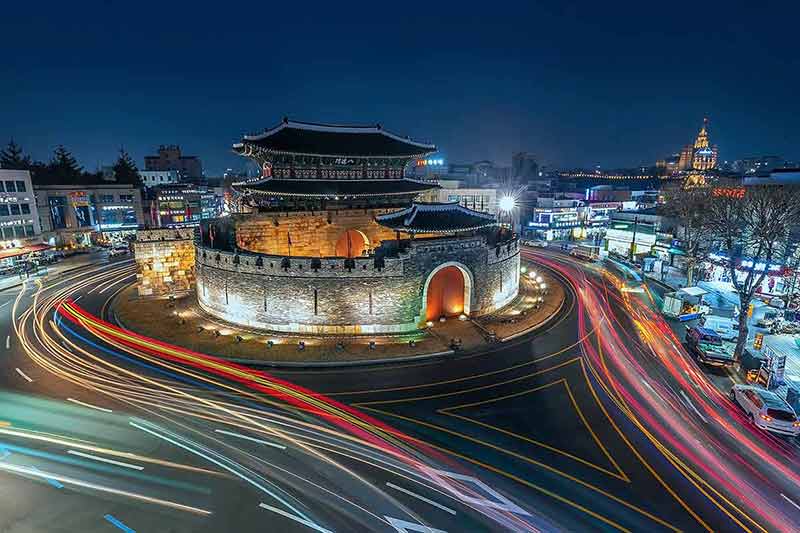
Gyeonggi-do is a province that surrounds Seoul and an area where many former Seoul residents fled because they could not afford the housing prices in Seoul to live in a less congested area.
It is too large to tackle as a single-day trip, so the suggested day trips from Seoul are Suwon, a folk village, and the Yi Dynasty Royal Tombs.
A day trip to the Hwaseong Fortress is also worth a visit.
The province has many beautiful parks, forests, temples and Buddhist shrines.
Gyeonggi-do is a large province that extends to the borders of North Korea. It has an array of national parks and a large seashore.
Incheon is a major city, and most visitors to South Korea arrive through Incheon Airport, which is connected to the Seoul Metropolitan Subway.
Suwon
Suwon is Gyeonggi-do’s capital, with approximately 1.3 million people.
It is easy to reach by subway as there are several stops along the Seoul Metropolitan Subway, the national railroad network and by car.
Suwon has several professional sports teams, 11 universities and two junior colleges.
Yi Royal Tombs
You will find the Yi Royal Tombs a fascinating delve into history.
The traditional method of royal burials was to bury the deceased in earthen mounds guarded by granite sentries or mythical animals.
Similar royal tombs exist throughout the country.
Korean Folk Village
Suwon’s Korean Folk Village is popular and often crowded.
The village offers a peek into South Korean culture, with artisans’ workshops, a Buddhist temple and dance performances.
Suwon is 34.5 km from Seoul. Travel options are: train (39 minutes) $1 to $6, subway (1 hour), $2 to $3, bus (2 hours) $11, taxi (31 minutes) $30 to $40, drive (31 minutes) $5 to $7.
4- Gangwon-do
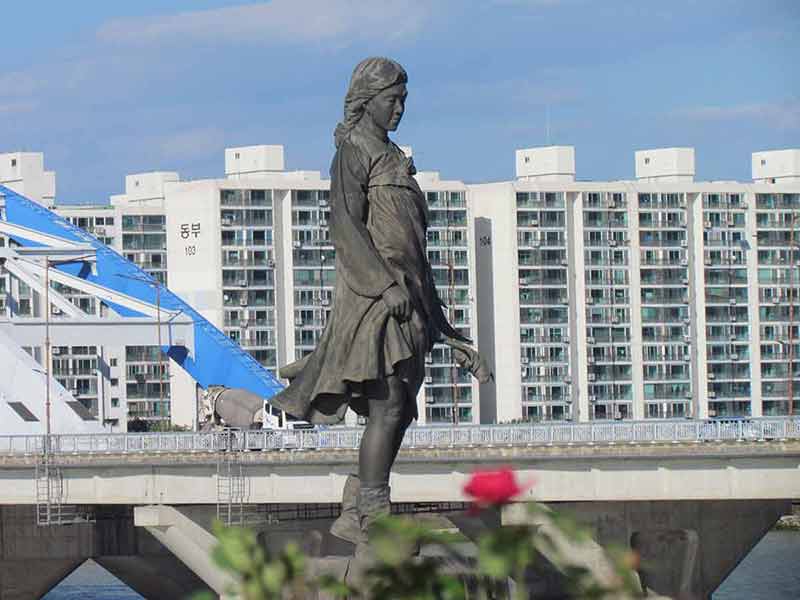
Gangwon-do is a province bordering North Korea in the country’s northeastern part.
Chuncheon, its capital, is an excellent stopover on your way to Soraksan National Park.
Visit the Unification Observatory to see the Demilitarized Zone.
Soraksan National Park and Odaesan National Park are highly recommended.
Gangwon-do is 95.1 km from Seoul. Travel options are train (1 hour, 48 minutes) $7 to $13, bus (2 hours) $13, subway (2 hours, 31 minutes) $2 to $4, taxi (1 hour, 13 minutes) $100. Find out more about joining this tour.
5- Daegu
Gyongsangbuk-do is a province that includes Daegu, Korea’s third-largest city and many interesting parks, including P’algongsan Provincial Park, Kaysan National Park and Chuwangsan National Park.
The province is dotted with Buddhist temples and folk villages.
Daegu is 277.3 km from Seoul. Travel options from Seoul Station to Taegu are train (2 to 3 hours) $23 to $53, bus (3.5 hours) $15 to $21 and car (3 hours).
6- Gyeongju (Kyongju)
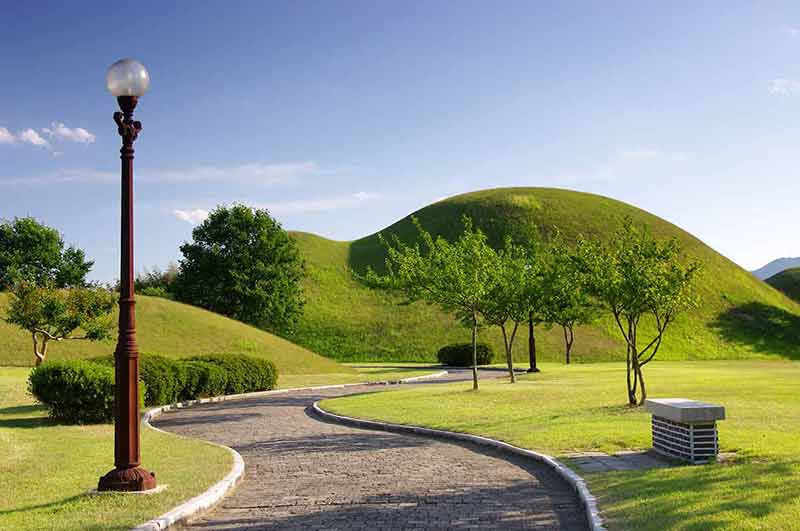
Korea was divided into several kingdoms, and Gyeongju was the capital of the Shilla dynasty.
The Mongols and the Japanese pillaged the city, but a tremendous amount of restoration work has been done, so visitors can see what life was like during the Shilla dynasty era.
You’ll be particularly fascinated by the royal tombs.
Gyeongju is 323.4 km from Seoul. The travel options are train (2.5 hours) $28 to $41, bus (3.5 hours) $15 to $24 and car (3.5 hours).
7- Busan
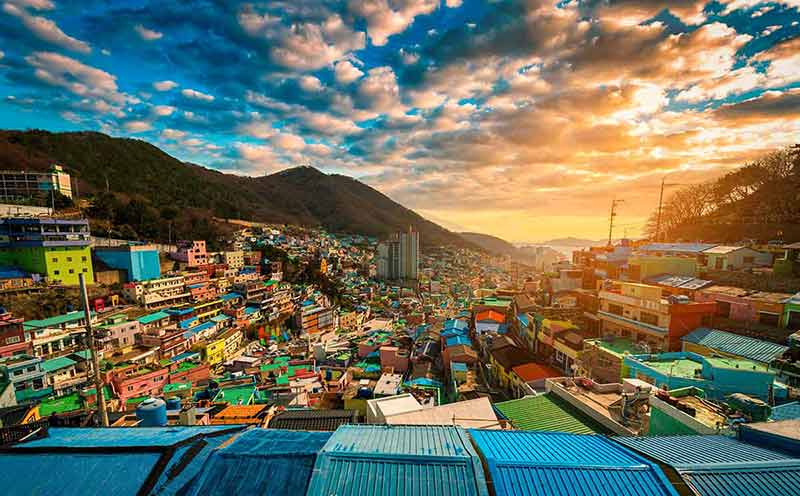
Busan is South Korea’s second-largest city and the main city in Kyongsangnam-do in the country’s southeast.
It escaped capture by the Communists during the Korean War.
Its ambience reflects its port city status and the large number of foreign sailors passing through.
It is huge, has an excellent subway, and visitors should consider bus tours.
In addition to the city of Busan, you should explore Kajisan Provincial Park, the Chinja Fortress, Yonhwasan Provincial Park, and Chirisan National Park.
Busan is 389 km from Seoul. Travel options are train (2 hours, 41 minutes) $17 to $50 or by car (4 hours). In Busan, this city tour will help you see the sights without the stress.
8- Namhae
Namhae-gun is also in Kyongsangnam-do and there is a surprising amount to do there.
Visit Namhae Pyeonbaek Recreational Forest, the Namhae German Village, the American Village, the Baram Heunjeok Museum of Art, the Namhae Bomulseom Jeonmangdae and Skywalk, numerous temples, and ocean scenery.
It’s a little further than other day trips from Seoul but if you leave early and stay out until after dark, you’ll be able to squeeze alot in.
Namhae is 361.7 km from Seoul. Travel options are but (4.5 hours) $27, train (4.5 hours) $76 to $103 or car ( 3 hours, 50 minutes) $44 to- $64.
9- Gwangju
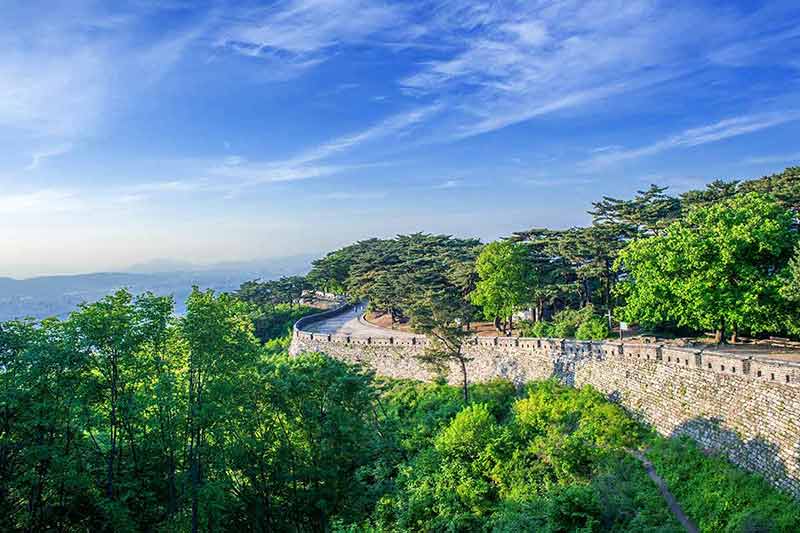
Gwangju is the Chollanam-do’s provincial capital and where you can learn about the Gwangju Massacre of students in 1980 during the protest against the military regime.
Chollanam-do is a province in Korea’s southwest that is dotted with islands and worth taking a ferry and exploring coastal areas.
Among the places to visit is Hwaomsa with its three temples, Yosu with its hydrofoil going back and forth to Pusan.
Other parks to explore are Chogyesan Provincial Park, Mudungsan Provincial Park, Tadohae Haesang National Park, Wolch’ulsan National Park and Turyunsan Provincial Park.
Gwangju is 292.8 km from Seoul. Travel options are train (2.5 hours) $13 to $41, bus (3.5 hours) $15 to $22 and car (3 hours) $36 to $52.
10- Daejeon
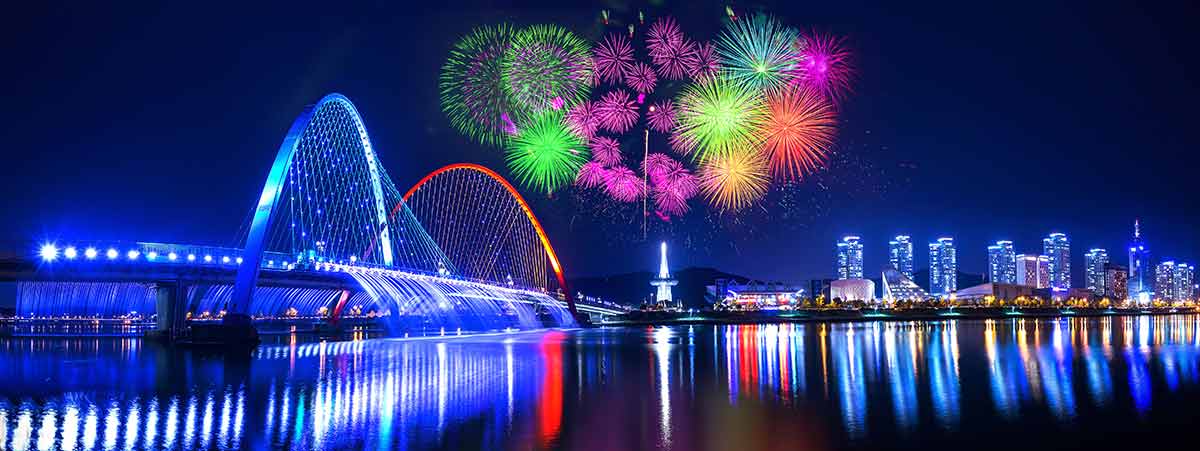
Daejeon is the main city in Gyongsangbuk-do and South Korea’s sixth largest city.
It’s an excellent transit point to visit other interesting places in the country.
Although Taejon is not stunningly beautiful, on its southern side is Pomunsan, a mountain park with temples and incredible scenery.
Daejeon has a science park, hot springs, and accommodations for a city of over one million people.
Daejeon is 154.7 km from Seoul. Travel options are train (1 hour), bus (from two hours) $7 to $14, car (1 hour, 42 minutes) $19 to $28.
- 20 Famous Landmarks in South Korea
- 20 Things To Do In South Korea
- 20 Best Beaches In South Korea
- 35 Things To Do in Seoul
- 20 Seoul Day Trips
- 20 Things To Do In Jeju Island
- 10 Things To Do In Gyeongju
- Andong Mask Dance Festival
- Jirisan National Park
- Korean Temple Stay Experience
- Seoul At Night
- 20 South Korean Cities
- Winter In Korea – 20 Things To Do
11- Jeju-do
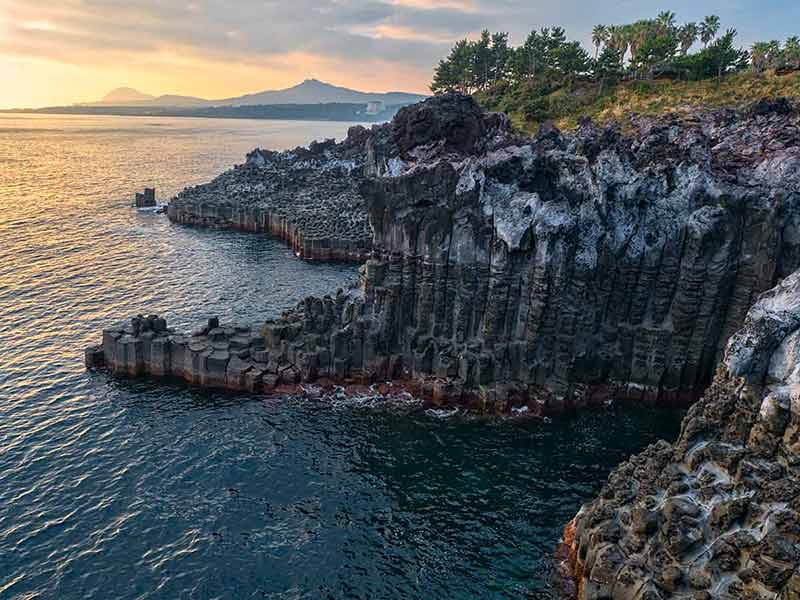
Jeju is Korea’s version of Hawaii and was isolated from the rest of the country for many centuries.
Jeju Island has a warmer climate than the rest of Korea and it’s where many South Koreans spend their honeymoon.
Recommended places are Jeju City, Ch’ungmun Beach, Song-up Folk Village, the volcanoes and the caves.
Walking to the peak of Mount Hallasan is one of the highlights, but the weather up to the summit can change dramatically, so bring something warm, good hiking shoes and rain gear.
It takes about 2.5 hours to climb to the top and there are several restaurants at the start of the trails.
The best way to visit as a day trip from Seoul is to fly (2.5 hours) which costs about $136 and when you arrive, book this full day tour to explore the island. Other travel options involving trains, buses and ferries can take more than seven hours.
12- Chonju (Jeongu)
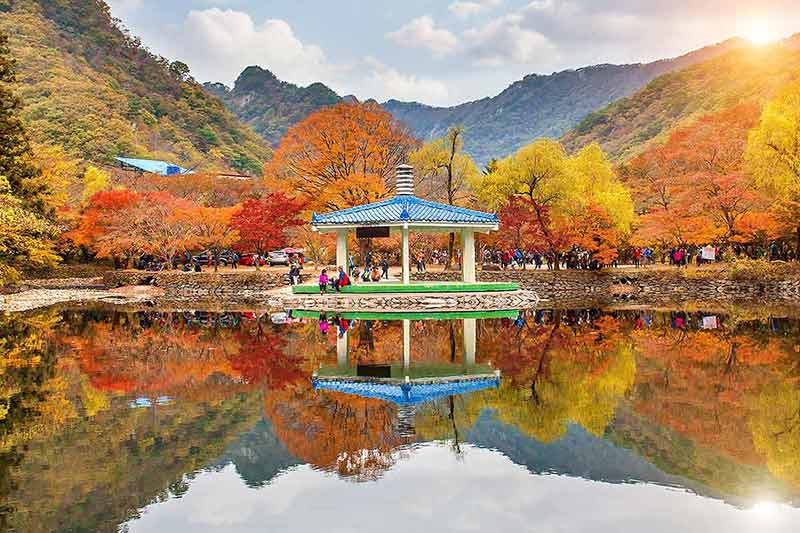
Chonju is the provincial capital of Chollabuk-do and a major transit area and it has inter-city bus and express bus terminals.
Points of interest are some Buddhist temples, including Anhaengsa and Ch’ilsongsa and a Confucian school.
Chollanam-do is the province just north of Chollabuk-do and home to Maisan Provincial Park, Togyusan National Park, Pyonsanbando National Park and Naejangsan National Park.
Chonju is 211 km from Seoul. Travel options to Chonju are train (3 hours) $12 to $38, bus (over 3 hours) $12 to $18 and car (over 2 hours) $26 to $38.
13- Chungchongnam-do
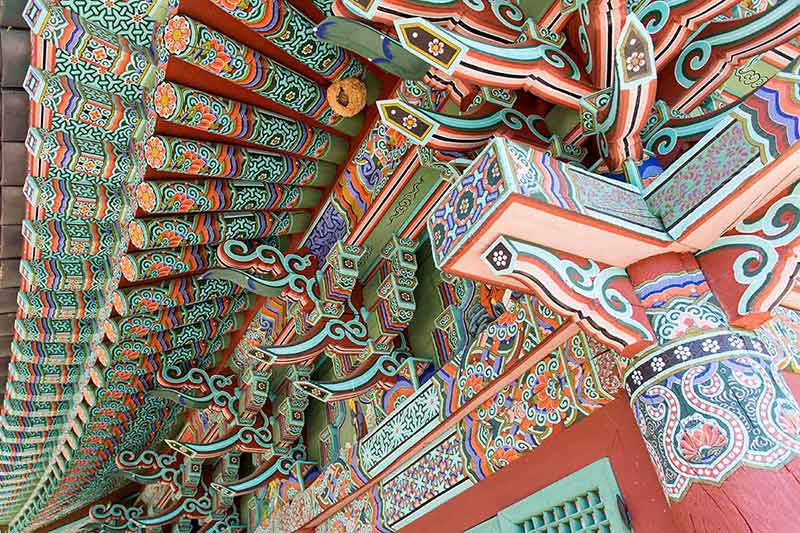
Chungchongnam-do has several wonderful parks and temples but you won’t have time to visit them all on a day trip from Seoul.
Make sure to see the Independence Hall of Korea in Ch’onan (Cheonon).
Taejunsan Provincial Park contains Kwanch’oksa, Korea’s second largest Buddhist temple containing stone lanterns and a five-story pagoda.
Locals know Kyeryongsan National Park as the rooster dragon mountain because the shape of the mountain resembles a rooster’s head.
Within the park are Kapsa, a Buddhist temple dating from the eighth century, and Tonghaksa, another Buddhist temple almost as old as Kapsa.
Another Buddhist temple you should visit is Magoksa to the northwest of Gongju, which has been there from when Chinese Tang culture was introduced in Korea around 632 AD.
Cheonon is 96.3 km from Seoul. Travel options to Cheonon are bus (1 hour, 14 minutes) $17 to $21, train (1.5 hours) $15 to $26, taxi (1 hour) $80 to $100 and car (1 hour) $12 to $17.
14- Gongju
Gongju became the capital of the Shilla kingdom in 457 A.D. after its first capital was abandoned.
It has famous tombs, a nearby fortress and a museum. Restoration work has begun to restore these treasures.
There is an annual festival held in October for three or four days.
Gongju is 128.5 km from Seoul. Travel options are but (1.5 hours) $10, taxi (1.5 hours) $110 to $140 and car (1.5 hours) $16 to $23.
15- Chunchonbuk-do
Chungchongbuk-do is the only province that is not bordered by an ocean.
It has several beautiful parks but it’s main attractions are Woraksan National Park, Sobaeksan National Park and Songisanan National Park, which you can visit during the same day trip.
Woraksan National Park has many hiking trails, while Sobaeksan National Park is a large park, but it lacks Soraksan’s rock formations and cliffs.
Songisanan National Park is home to the impressive Popchusa temple, which was constructed during the Shilla dynasty and is home to the largest Buddha statue in northeast Asia.
Ch’unch’onbuk-do is 173.8 km from Seoul. Travel options are train and taxi (two hours) $57 to $84, car (two hours) $22 to $31.
- 15 Day Trips From Sydney
- 5 Day Trips From Melbourne
- 20 Day Trips From London
- 20 Day Trips From Boston
- 20 Day Trips From Mexico City
- 20 Day Trips From Miami
- 20 Day Trips From Orlando
- 20 Day Trips From Brisbane
- 20 Day Trips From Seoul
- 20 Day Trips From Paris
- 20 Day Trips From Las Vegas
- 20 Day Trips From Lisbon
- 20 Day Trips From Porto
- 20 Day Trips From Dubrovnik
- 5 Day Trips From Bern
- 5 Day Trips From Barcelona
- 3 Day Trips From Osaka
- 20 Day Trips From Madrid
- 20 Day Trips From Tulum
- 20 Day Trips From Cancun
- 20 Day Trips From Los Angeles
- 20 Day Trips From San Francisco
- 20 Day Trips From Dallas
- 20 Day Trips From Houston
- 20 Day Trips From Austin
- 20 Day Trips From Charlotte
- 20 Day Trips From Philadelphia
- 20 Day Trips From Amsterdam
Plan Your Trip

Rent A Car – Find the best car rental rates at Discover Cars. They compare car hire companies to provide you with the best deal right now.

Find A Hotel – If you’re curious about this article and are looking for somewhere to stay, take a look at these amazing hotels.

